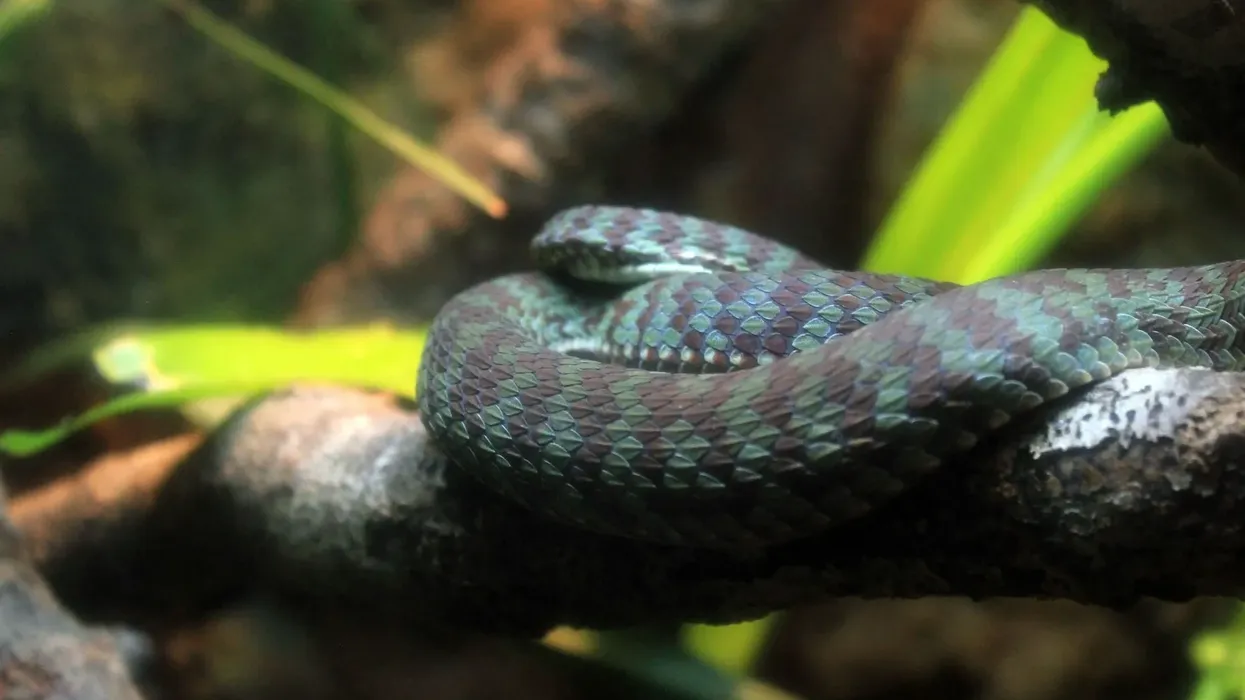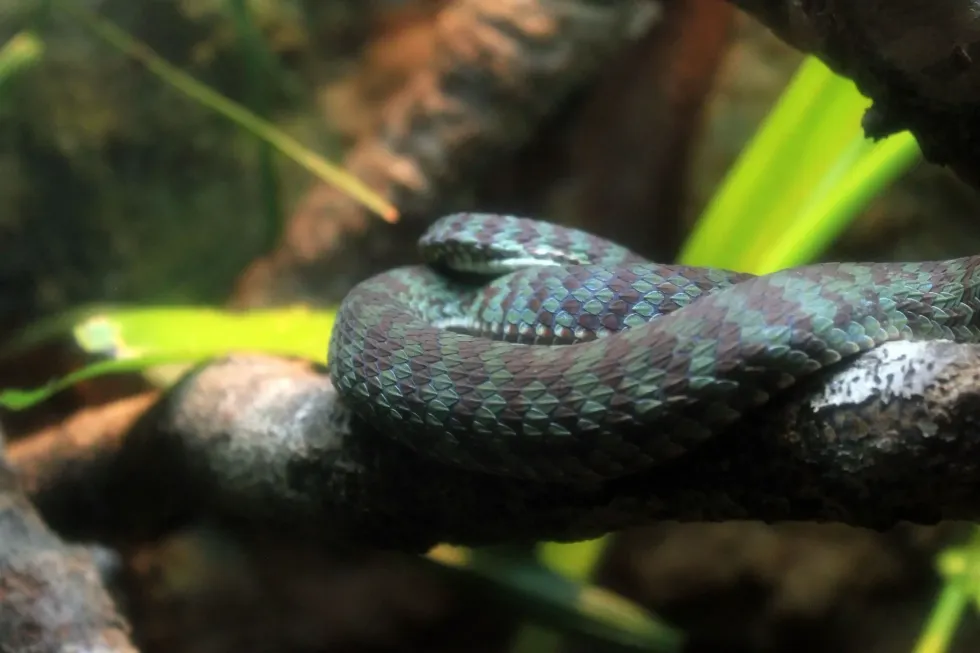The Kanburi pit viper is a beautiful species of snake found around Southern and Western Siam in Thailand. Their preferred habitat is the limestone hills in Kanburi, which is also why they are called the Kanburi pit vipers.
Cryptelytrops kanburiensis, Trimeresurus kanburiensis are their two scientific names. Pit vipers have two heat sensors on two sides of their faces that enable them to locate prey easily as they are primarily nocturnal.
Although, male individuals are likely to be spotted during the day as well on occasion. This is also what makes them different from vipers.
Pit vipers are known to live a long life, with the highest record being 25 years, and this is true for this snake species as well. These snakes from Thailand are thought to have a semi-high venom flow, which can cause serious damage to skin tissue.
They are also extremely agile and are known to strike fast. Their coloring helps them to blend into the surroundings of their habitat, making them hard to spot.
There are many fun facts about these snakes. To learn more, please read on.
If you would like to learn more interesting facts about animals, please check out puff adder and gray rat snake.
Kanburi Pit Viper Interesting Facts
What type of animal is a Kanburi pit viper?
The Cryptelytrops kanburiensis (Kanburi pit viper) is, as the name suggests, a snake. It is part of the pit viper family and is known to be highly venomous. They are found mainly in the Kanchanaburi province in Thailand.
What class of animal does a Kanburi pit viper belong to?
Like all members of the snake family, the pit viper Trimeresurus kanburiensis belongs to the class reptilia. Their scale colors help them camouflage so well that you will not even realize one is next to you until it is too late!
How many Kanburi pit vipers are there in the world?
It is hard to say just how many of the pit viper Trimeresurus kanburiensis are left there in the world. However, as they are termed as one of the most endangered species of pit vipers, it can be assumed that the number of these beautiful species of vipers is not very high.
Where does a Kanburi pit viper live?
The Kanburi pit viper (Trimeresurus venustus) is endemic to Thailand. They can mostly be found in the limestone hills of the Kanburi range, which is in South-Western Siam.
The main locality is thought to be Kanchanaburi in the Kanchanaburi province of Thailand. Reports suggest that there have been sightings of a few individuals in some other areas near their main home range.
What is a Kanburi pit viper's habitat?
The Trimeresururs kanburiensis is a species of pit vipers that are known to stay pretty close to the ground level in bamboo forests and open woodlands, which happens to be their preferred habitat. They are often found around human inhabitance and are also known to prefer areas near water bodies.
This species of vipers are known for their excellent camouflage capabilities, which they use to hide between rocks and under dry leaves.
This is one of the factors that makes this pit viper Trimeresurus kanburiensis species so deadly. It also makes them pretty hard to find in the wild.
Who do Kanburi pit vipers live with?
Like most species of pit vipers, the Trimeresurus kanburiensis is also known to be primarily solitary except for the mating season.
How long does a Kanburi pit viper live?
It is hard to say just how long the pit viper Trimeresurus kanburiensis species live. However, as most pit vipers are known to live a long and healthy life, it can be assumed that their average lifespan can be 12-18 years.
How do they reproduce?
Very little is known about the mating habits of the pit viper Trimeresurus kanburiensis. The mating season of this species of pit vipers is thought to be during September-October, which is also the time when the most recorded sightings occur.
Females, after a gestation period lasting a few months, give birth to live babies during April-May when they re-emerge from their hibernation. About 4-16 babies are born and are left to fend for themselves right from their birth.
What is their conservation status?
The Cryptelytrops or Trimeresurus kanburiensis is listed as an endangered species in the IUCN red list. Their numbers are thought to be frequently decreasing because of the illegal pet trade. Although currently, efforts are being made to protect them thoroughly in their habitat range as well as in nature parks.
Kanburi Pit Viper Fun Facts
What do Kanburi pit vipers look like?
The Cryptelytrops kanburiensis is a medium-length snake. Their colors vary from brown to tawny with dark spots or patterns.
The population in southern Kanchanaburi looks a lot similar to Trimeresurus venustus, which is why they were previously considered to be members of that species. It is only recently that they were declared different.
The only way to differentiate them is probably by the first three of the superlabial scales, which happen to be longer in the Kanburi pit vipers.
How cute are they?
The Trimeresurus kanburiensis actually look deadly rather than cute. They are masters of camouflage with their brown and tawny coloring with dark blotches and patterns.
They use their coloring to blend into the surroundings of their habitat, which are often among dry leaves or between rocks. As they are mostly found around the limestone hills in Kanchanaburi, Thailand, these added advantage makes them really hard to spot.
How do they communicate?
Snakes often use chemical trails as well as heat sensors to communicate with each other. They follow these chemical trails and heat sensors to find mates and locate prey.
How big is a Kanburi pit viper?
The Trimeresurus kanburiensis are small-sized snakes. Their average length is about 19.7-27.5 in (50-70 cm). They are about the same size as the Trimeresurus venustus species, whose range length is about 19.7-27.5 in (50-70 cm). They are, however, smaller than the white-lipped pit viper species, whose range length is about 29.5-40.9 in (75-104 cm).
How fast can a Kanburi pit viper move?
While it is hard to determine their exact speed, the Trimeresurus kanburiensis is one of the fastest striking pit vipers found in Thailand. This is due to their small size and excessive agility.
How much does a Kanburi pit viper weigh?
It is hard to say just how much the Cryptelytrops kanburiensis weighs, but given their small size, it can be assumed that their average weight is not much.
What are the male and female names of the species?
Snakes, in general, do not have gender-specific names, and this is true for the Trimeresurus kanburiensis as well. Male snakes are just called male snakes, and females are just called female snakes. Cryptelytrops kanburiensis and Trimeresurus kanburiensis are their common scientific names.
What would you call a baby Kanburi pit viper?
As with all snake species, the babies of the Crypelytrops are called snakelets. They are born live, being hatched inside of the mother's body, and are known to hunt for themselves right from the beginning.
What do they eat?
Like most pit vipers, the pit viper Trimeresurus kanburiensis species is mostly nocturnal and comes out of its hiding to hunt at night. During their mating season, though, males are often found wandering around during the day as well.
Adults primarily feed on geckos, squirrels, and birds, while the young are more likely to hunt down frogs and lizards to eat. They tend to poison their prey and then leave them. After that, they follow their heat sensors to locate their prey and then swallow them whole.
Are they poisonous?
Although nothing specific is known about the Kanburi pit viper venom, they are actually thought to have a high venom flow. As they often wander around human inhabited places, a few case reports are heard per year. Although, fatality rates are unclear.
Would they make a good pet?
These snakes are shy and prefer a solitary life. Not only that, but as with all wild animals, they are highly unpredictable and are likely to become aggressive on occasion.
So, as they are venomous, it is possibly better for both the snake as well as for you not to keep them as pets. They are also listed as an endangered species, so keeping them as pets might need special permission from the government.
Did you know...
Males are likely to have a white line running down below their eyes.
Females tend to be longer than males.
The babies look like miniature versions of the adults.
Is the Kanburi pit viper endangered?
The Trimeresurus kanburiensis (Kanburi pit viper) is listed as an endangered species in the IUCN red list. The reason for their constantly decreasing numbers can be attributed to the illegal pet trade. However, currently, actions are being taken to protect them in their home ranges as well as in some nature parks.
How did the Kanburi pit viper get its name?
The Trimeresurus Kanburiensis or Cryptelytrops kanburiensis, commonly known as the Kanburi pit viper, gets its name from its most populated area, that is, of course, the limestone hills in Kanburi or the Kanchanaburi province. As they are mostly found in that region of Thailand, they automatically got named the Kanburi pit viper.
Here at Kidadl, we have carefully created lots of interesting family-friendly animal facts for everyone to discover! For more relatable content, check out these scarlet snake facts and vine snake facts for kids.
You can even occupy yourself at home by coloring in one of our free printable snake coloring pages.









